January’s Fungi Focus: Witches’ Butter, Warlock’s Butter and Yellow Brain
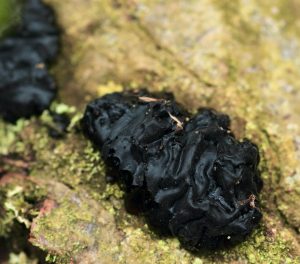
There are some who argue that the prime fungi hunting season basically comes to an end with the first frosts around November time. There is still plenty to see on those wintry woodland walks around the turn of the year however. In these mid to late winter months, the more conventional cap-and-stem types might be thinner on the ground, but if you care to cast your eyes around to more woody substrates, you should be sure to find a variety of crusts, brackets, tiny ascomycetes and, the subject of this month’s fungi focus, jellies. Examples of fungi that form soft and gelatinous fruitbodies include the blobby types like Orange Jelly Spot (Dacrymyces stillatus) and Crystal Brain (Exidia nucleata) to more complex and distinctive fruiting forms like the branching Yellow Stagshorn (Calocera viscosa) and the subject of a former post, the Jelly Ear (Auricularia auricula-judae).
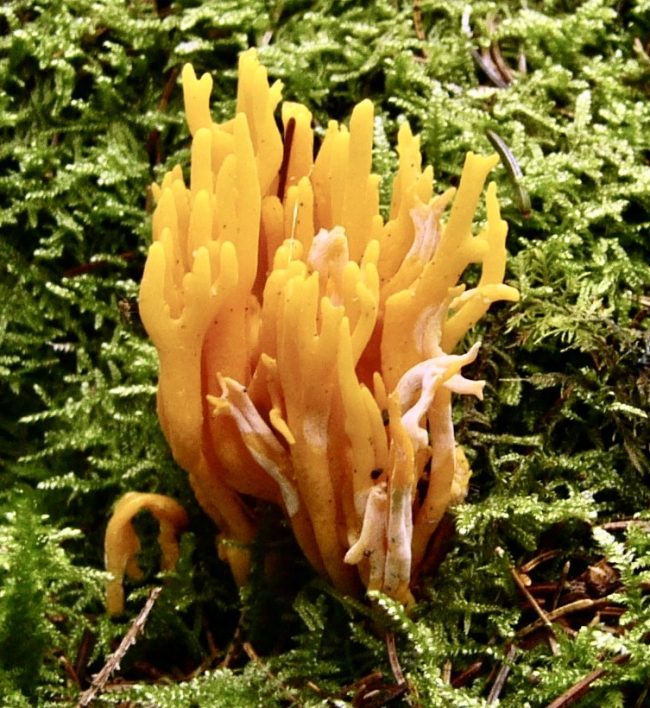
One of the more distinctive jelly fungi, Calocera viscosa or the Yellow Stagshorn.
The fruitbodies, as regular readers of these posts will know, are really only the reproductive organs that release spores, with the main part of the fungi consisting of a filamentous network running through and feeding upon its chosen substrate. The examples cited above are all decomposers of dead wood, with the Jelly Ear primarily (although not exclusively) associated with elder. There are also jelly fungi that act as parasites or decomposers of plants and other fungi, as the recently published two-volume Fungi of Temperate Europe highlights, and not all produce such obvious fruitbodies. Some occur as “almost invisible films on, for example, wood.” Even this mycological bible draws the line in excluding from its otherwise comprehensive pages those that “form resupinate, mostly invisible fruitbodies”, presumable acting on the assumption that unless you are a scientist equipped with all the correct tools and the knowledge of where to look, you’ll have no chance to finding them anyway.
There are a lot of species that fall within this massive category of the jelly fungi then. I shall, however, deal only with the more common and readily identifiable here to describe a few basic characteristics of their composition.
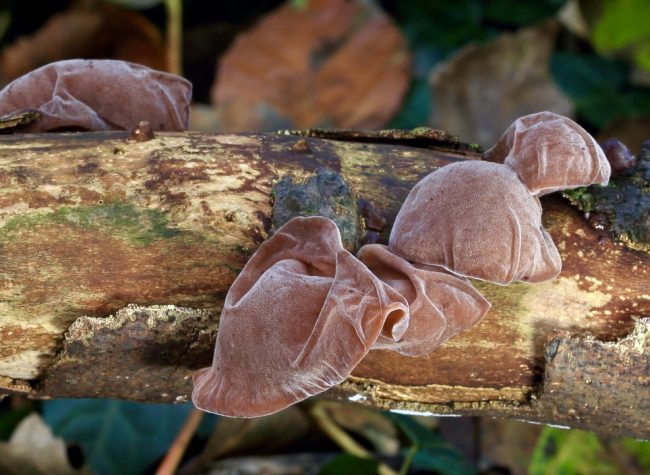
The Jelly Ear (Auricularia auricula-judae), one of the most common and easily identifiable of the jelly fungi.
Like other fungi, the fruitbodies are comprised of the long threadlike cells known as hyphae interwoven together, individually so thin as to be invisible without a microscope and a staining agent applied to the sample. In this case though, this network of hyphae is surrounded by a protective gel. What this effectively means is that jelly fruitbodies are remarkably durable and robust compared with other fungi. They can freeze solid, dehydrate, defrost and rehydrate and still maintain their visible form – although admittedly taking a bit of a battering in the process – and can persist for some time. This makes them the perfect candidate for a fungi focus during the colder months when many are most prevalent, although most can be found during damp spells throughout the year.
The basidia, the microscopic reproductive structures emerging from the hypha that produce the spores, are longer than those of most other fungi. They are embedded within this gelatinous body, with the little prongs or horns that bear the spores (called sterigmata) protruding just above the surface. So basically the surface skin, or hymenium, of these gelatinous fruitbodies is where the spores are released from. If you wish to take a spore print, simply lay the fungus face down on a piece of black paper or a microscope slide: One of the things that seems to characterises the spores of the examples I’ve mentioned, aside from the fact that they leave white prints, is that they are relatively large and ‘allantoid’: that is, fat and sausage or banana-shaped.
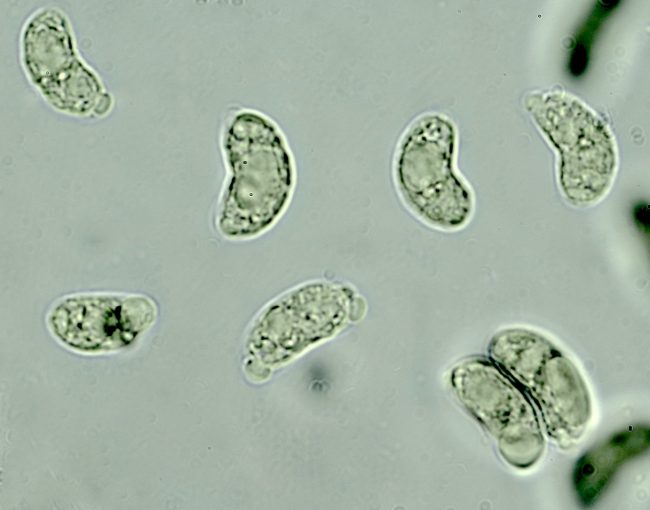
The fat allantoid sausage-shaped spores of Exidia plana
In the interests of keeping things clear and simple, I had hoped to avoid much in the way of mention of microscopic details and Latin names in this and future posts. The latter in particular can be very cryptic and daunting to non-biologists (among whom I include myself, I should add!). While the point of the Latin binomial names is to position the species in question accurately within a taxonomic tree-of-life that highlights its relationship with other similar species, one of the points of frustration I’ve heard from even the most seasoned of mycologists is that new genetic identification techniques have seen many types reassessed, reclassified and consequently renamed.
Just to give an example, the aforementioned Crystal Brain, a near translucent blob with white crystalline grains contained within it, is still referred to on the British Mycological Society website as Exidia nucleata, drawing attention to its family resemblance to the slightly more opaque and crystal-less White Brain, Exidia thuretania. However, Fungi of Temperate Europe, which only provides Latin names, lists it as Myxarium nucleatum.
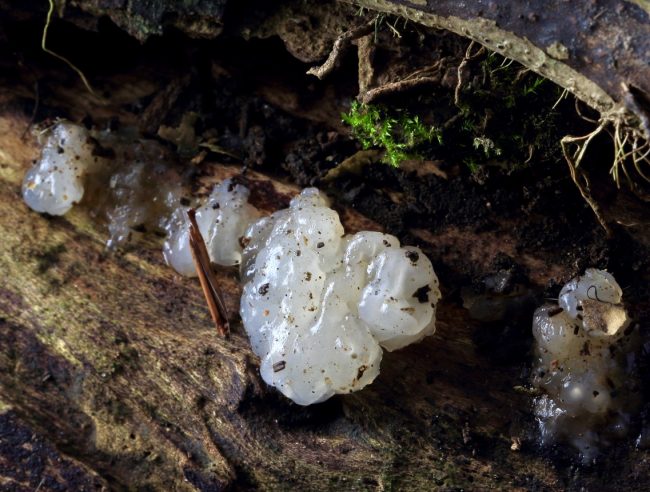
The White Brain, distinguished from the the Crystal Brain by the absence of crystals
I cannot even begin to fathom the reasons for this renaming, and on my own side, I don’t really feel the need to care. For me, a Crystal Brain is first and foremost a Crystal Brain – a name that describes how it looks. However, I am using this example to introduce another similar type whose common name, Witches’ Butter, goes to show how these more instinctive and traditional English descriptors can be vague and imprecise and mean very different things to different people.
Sticking “Witches’ Butter” into Wikipedia amply demonstrates the problem, with the site claiming the term can refer to ‘Exidia nigricans, a black, gelatinous fungus; Exidia glandulosa, a black, gelatinous fungus; Tremella mesenterica, a yellow, gelatinous fungus; Dacrymyces, a jelly fungus often confused with Tremella; Nostoc, a genus of gelatinous cyanobacteria” – i.e, this last one isn’t even a fungus!
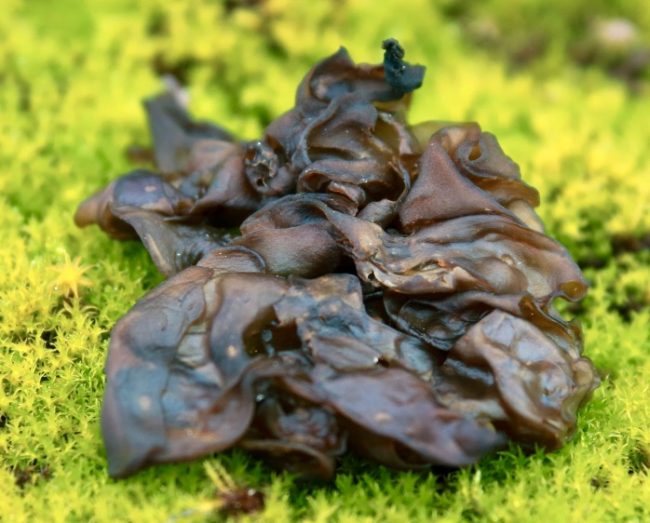
Nostoc, a cyanobacteria with a gelatinous sheath that is not even fungal in nature is also referred to as Witches' Butter
The BMS website states that Witches’ Butter is the common name for Exidia glandulosa, while the Dictionary software sitting on my Mac desktop describes it as “a black gelatinous European fungus which forms folded cup-like masses on dead wood. Exidia plana, family Tremellaceae, class Hymenomycetes”: Exidia plana is a synonym for Exidia nigricans, whose given common name according to the BMS is Warlock’s Butter.
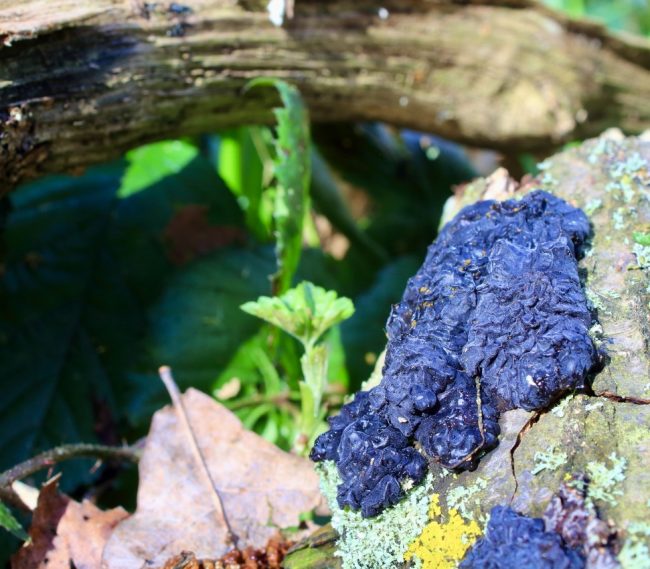
A partially dried out patch of Exidia plana, either Witches' Butter or Warlock's Butter, whichever you fancy.JPG
Confused? Well, what we can at least say is that whether applied to Exidia glandulosa or Exidia plana/Exidia nigricans, Witches’ Butter usually refers to a semi-translucent black or dark brown jelly-like excrescences that appear on dead or dying standing or fallen trees and branches.
Exidia glandulosa is described by Fungi of Temperate Europe as “turbinate”, with a hairy upper side and “a more grey-black, finely warty lower (hymenial) lower side” (i.e. the surface containing the basidia from which the spores are released). Michael Jordan in The Encyclopedia of Fungi of Britain and Europe describes a “contorted disc-shape”. Pat O’Reilly on the First Nature website writes that “individual fruit bodies grow to between 1 and 2cm across, sometimes coalescing to create larger masses typically 3 to 10cm across”. In drier times, these fruitbodies are a lot harder and shrivelled, but “are revived in wet weather and regain their expanded shape and gelatinous texture.”
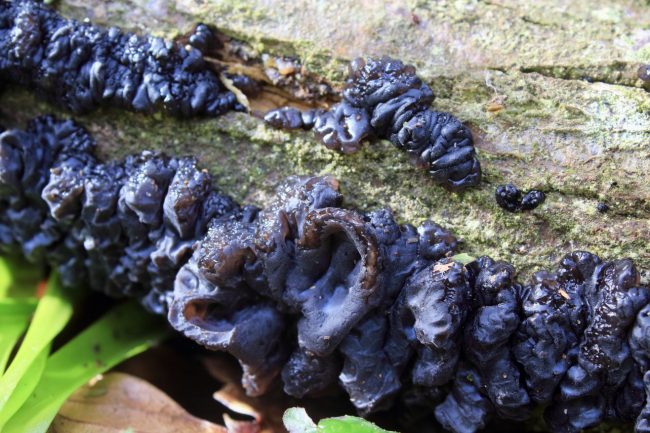
The fusing blobs and brain-like folds of Exidia plana.
Exidia plana/nigricans, which seems to be a lot more common around my particular neck of the woods, might initially look as similar as to effectively be treated as the same thing. Even down at microscopic level, the spores are the same allantoid sausages and pretty much the same size, at 12-17 x 4-5 microns. The key difference, which is quite obvious in most cases, is that the jelly bodies tend to spread wider and eventually fuse together, rather than appear as the “irregular flattish-faceted separate blocks of black jelly-like material” of E. glandulosa described by First Nature . All of the sources cited above mention its brain-like wrinkles and folds. And to confuse matters further, Fungi of Temperate Europe also lists a certain Exidia pithya, which forms a thinner layer of tar-black jelly but is only found on conifers, and mainly on fallen spruce (Picea). I think most of us would be quite content in overlooking these subtle differences and ignoring the Latin names to just settle with calling all of them Witches’ Butter.
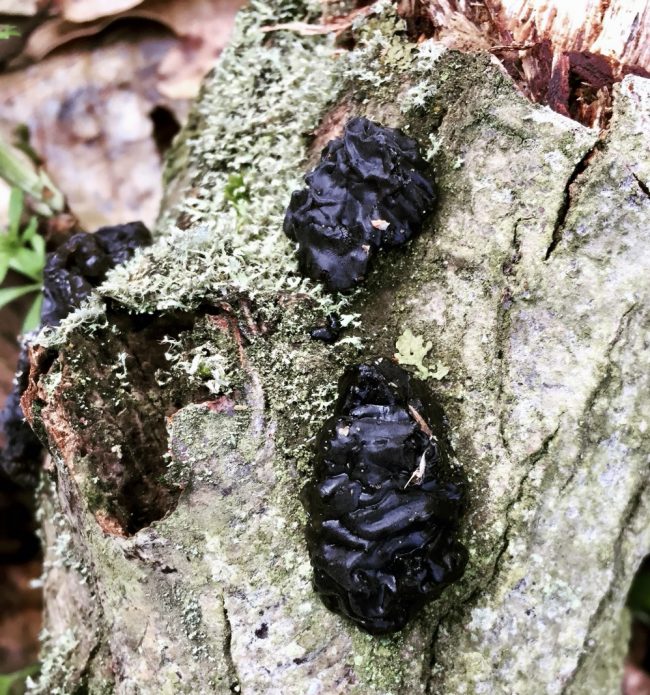
Buttery black blobs of Exidia plana, aka Exidia nigricans, aka Warlock's Butter, aka Witches' Butter.JPG
But where did this common name come from anyway? An older book, The Romance of the Fungus World (1925) by R. T. Rolfe and F. W. Rolfe, after referencing the alternative folk name of Fairy Butter and mentioning its “buttery” (?) appearances, cites an even earlier text, R.C.A. Prior’s On the Popular Names of the British Plants (1863), as stating its “unaccountably rapid growth in the night, which has given rise to a superstitious belief, still prevalent in Sweden (where it is called “troll smör” or Troll’s Butter), that witches (and trolls) milk the cows and scatter about the butter.”
This Nordic connection was noted even further back in 1777, in John Brand’s Popular Antiquities, which notes that in Sweden it was believed that the devil gave witches “a beast about the bigness and shape of a young cat, which they call a carrier. What this carrier brings they must receive for the devil. These carriers fill themselves so full sometimes, that they are forced to spew by the way, which spewing is found in several gardens where Colworts grow [i.e. cabbages], and not far from the houses of these witches. It is of a yellow colour like gold and is called ‘Butter of Witches.’”
Golden blobs of cat spew on cabbages sound more likely to be the slime mould Fuligo septica, (aka Dog’s Vomit Slime or Flowers of Tan), than any of the dark-coloured Exidia jelly fungi species found growing on dead wood.
There is, however, one further jelly fungus that is “of a yellow colour like gold” and sometimes also referred to as Witches’ Butter, as noted by Wikipedia, although this time it is in the Tremella rather than the Exidia genus. This is the Yellow Brain Fungus (aka Golden Jelly). To add further to the confusion, this kind of Yellow Brain / Witches’ Butter actually describes two different species that look more or less identical.
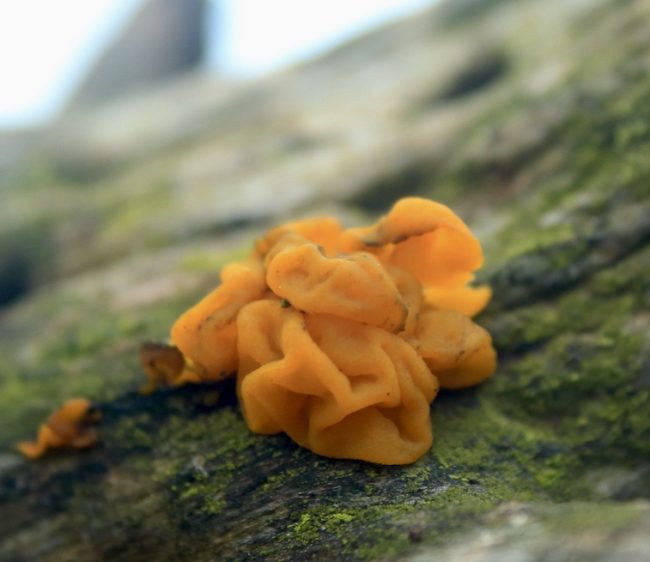
Tremella mesenterica, one of the two jellies known as Yellow Brain Fungus, and one of many referred to as Witches Butter
Essentially their fruitbodies are lobed or pustular semi-translucent swellings with folds and bumps that are slightly more pronounced than the Crystal Brain, White Brain, Warlock’s Butter (E. plana/nigricans) and “real” Witches’ Butter, E. glandulosa. Aside from the colour, and the fact that under the microscope their spores are small and round (not big and bendy), the crucial difference is that while you will find them both growing on dead deciduous wood such as fallen tree trunks or branches, they are actually parasitizing another fungus that is already decaying the wood. In the case of Tremella mesenterica, the Yellow Brain is actually growing on the mycelium of the corticioid crust fungus in the Peniophora genus, which are decomposers that manifest themselves as smooth, tough waxy patches of grey tinged with beige, red or violet, depending on the species.
Tremella aurantia, meanwhile, looks virtually the same, but its main host is another more conspicuous resupinate, which I covered last year, the Hairy Curtain Crust (Stereum hirsutum). (It also apparently has a taste for other Stereum species too). Basically, if you find a pile of logs with Hairy Curtain Crust growing from them, have a look around, and any yellow brain-like blob you find will most likely be Tremella aurantia, while if there’s a greyish leathery patch growing on the wood surface, it’s probably Tremella mesenterica.
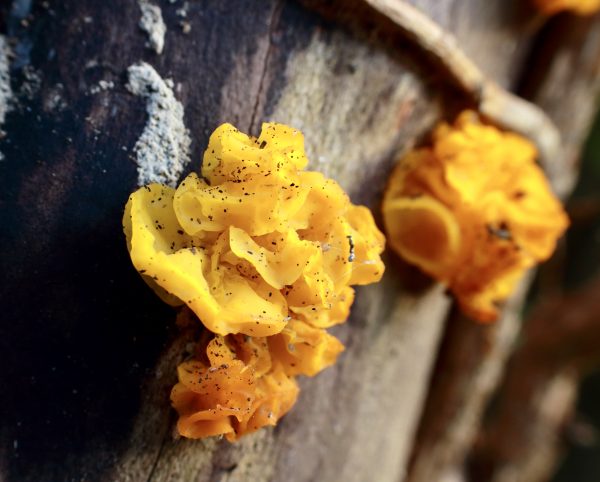
The grey patches of what might be a Peniophora resupinate fungi suggests this Yellow Brain is probably Tremella mesenterica.JPG
Either way, you’ll probably just want to avoid confusion and just call it Yellow Brain (to add insult to injury, Fungi of Temperate Europe has given T. aurantia another name, Naematelia aurantia). Or add to the confusion and refer to it as Yellow Witches’ Butter. You might not be wrong in either case, but you should be able to see now how complicated the relationship between common names and Latin names can be with the particular fungus they might be applied to.
Comments are closed for this post.

I try to correct posts that label yellow brain as witches butter, this led me to this site which I need to read again.
It’s interesting.
Wayne Yalland
26 January, 2023